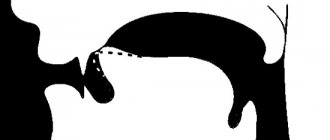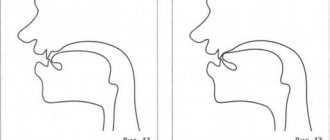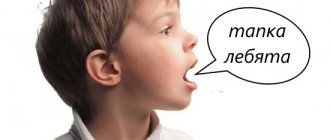D, d - The fifth letter of almost all Slavic Cyrillic alphabets, and in Ukrainian - the sixth. It is also used in Cyrillic scripts of other languages. In the Old and Church Slavonic alphabets it is called “good”; in Cyrillic it looks like and has the numerical value 4, in Glagolitic - like it has the numerical value 5. The Cyrillic form comes from the Byzantine statutory style of the Greek letter delta - which, like the current printed Cyrillic D, was drawn with “paws” at the bottom; Glagolitic style is also traced back to the Greek delta, but lowercase and italic.
Examples of words starting with the letter "D"
#WordsWords starting with the letter "D"House, smoke, tree, dragon, roadWords ending with the letter "D"Grandfather, iodine, lord, deliriumWith the letter "D" in the middle of the wordFood, water, vodka, poor, budgetWords containing several letters "D" Grandfather, judo, income, madhouse, maternity hospitalCountriesDenmark, Djibouti, Dominican Republic, Dominica. See all countries starting with the letter “D” Cities Donetsk, Dubai, Dresden, Damascus, Dakar, Delhi. See all cities starting with the letter “D”AnimalsDolphin, woodpecker, porcupine, blackbird. See all animals starting with the letter “D” Vegetables, fruits and berriesMelon, dragon fruitProfessionsJanitor, designer, diplomat, conductor, trainer. See all professions starting with the letter “D” All names starting with the letter “D” with meanings and origins Male names David, Danil, Denis, Dmitry, Damir. See all male names starting with the letter “D”, as well as their meaning and origin. Female names Darina, Dinara, Dina, Daria, Jennifer. See all female names starting with the letter “D”, as well as their meaning and originConsonant devoicing rule
In the Russian language, it is not uncommon for a letter to be written in writing to denote a voiced consonant, but in speech it turns into a voiceless consonant. This happens, for example, when a voiced letter appears at the very end of a word, as in the word mushroom, the transcription of which will look like [flu].
Due to the fact that voiced consonants are deafened at the end, difficulties often arise when reproducing such words in writing. However, there is an easy way to check which letter to use: you need to change the word so that the consonant appears before the vowel, for example, mushroom - mushroom. Then it will immediately become clear what needs to be written. The same applies to cases when there is a voiceless consonant at the end, and in writing it is voiced “according to the general rule.” You can check which letter is written in the same way: krik - krik, lot - lota.
Voiced consonants located in positions at the beginning and in the middle of a word can also be deafened if they are followed by a voiceless consonant. This is easy to understand using an example: booth [booth].
Study Materials
Poetry
* * * Here is a house where there are good friends, There is smoke above the house, and there is a door in the house. We guessed, you and I, what we need to write now.
Poems about the letter "D"
Puzzles
* * * Dolphin, our cheerful dolphin, is not alone playing in the sea, There are two dolphins on the water, While playing, they are learning the letter...
Riddles about the letter "D"
Tongue Twisters
* * * The letter D calls grandfather’s dear friend to dinner. Grandfather calls Dimka with him, Dimka calls his pussy Dymka.
Tongue twisters starting with the letter "D"
Fairy tales
Paired and unpaired voiceless consonants
Most sounds that fall into this category have a voiced pair. What sounds these are, you can find out from the table “Voiceless consonant sounds in the Russian language.”
| Voiceless consonant | Voiced consonant |
| [P] | [b] |
| [P'] | [b'] |
| [f] | [V] |
| [f'] | [V'] |
| [To] | [G] |
| [To'] | [G'] |
| [T] | [d] |
| [T'] | [d'] |
| [With] | [h] |
| [With'] | [z'] |
| [w] | [and] |
Thus, in the Russian language there are 11 voiceless consonants that have a voiced pair. But there are also unpaired ones - these are sounds such as [x], [x'], [h'] and [uh'].
They cannot become voiced regardless of position.
A special mnemonic phrase helps to remember all the voiceless consonants that exist in the Russian language: “Styopka, do you want shchetc?” - Ugh!". But it will not help to remember their pairing by hardness-softness, since voiceless consonants that have a pair are presented in it only in one variety - either hard or soft.
Features of sound articulation
[E]. The lips are stretched into a smile. The tip of the tongue is located at the lower teeth, the back of the tongue is raised.
The exhaled air does not meet any obstacles in the mouth. The vocal cords are working, the throat is trembling (there is a voice).
Characteristic. The sound [YE] is a vowel.
Letter color designation. The letter is colored red.
Scheme 31. Sound [P']
Features of articulation. The lips are closed and open under the pressure of exhaled air. The tip of the tongue is pressed against the lower teeth, the back of the tongue is arched.
The vocal cords are resting, the throat is not trembling (no voice). Characteristic. The sound [P'] is a soft, voiceless consonant. Letter color designation. The letter is colored green.
Diagram 32. Sound [B']
Features of articulation. The lips are closed and open under the pressure of exhaled air. The tip of the tongue is pressed against the lower teeth, the back of the tongue is arched. The vocal cords are working, the throat is trembling (there is a voice).
Characteristic. The sound [B'] is a soft voiced consonant.
Letter color designation. The letter is colored green.
Diagram 33. Sound [T']
Features of articulation. The tip of the tongue rests on the lower teeth, the back of the tongue is curved into a steep hill and is pressed with the front part against the tubercles behind the upper teeth. Under the pressure of exhaled air, the front part of the tongue comes off the tubercles. The vocal cords are resting, the throat is not trembling (no voice).
Characteristic. The sound [T '] is a soft, voiceless consonant.
Letter color designation. The letter is colored green.
Diagram 34. Sound [D']
Features of articulation. The tip of the tongue rests on the lower teeth, the back of the tongue is curved into a steep hill and is pressed with the front part against the tubercles behind the upper teeth. Under the pressure of exhaled air, the front part of the tongue comes off the tubercles.
The vocal cords are working, the throat is trembling (there is a voice). Characteristic. The sound [D'] is a soft voiced consonant.
Letter color designation. The letter is colored green.
Scheme 35. Sound [S']
Features of articulation. The teeth are close together. The lips are stretched into a smile. Tip
the tongue rests on the lower teeth, the back of the tongue is arched.
The vocal cords are resting, the throat is not trembling (no voice). Characteristic. The sound [С'] is a soft, voiceless consonant. Letter color designation. The letter is colored green.
Diagram 36. Sound [3']
Features of articulation. The teeth are close together. The lips are stretched into a smile. The tip of the tongue rests on the lower teeth, the back of the tongue is arched.
The vocal cords are working, the throat is trembling (there is a voice). Characteristic. The sound [3′] is a soft voiced consonant.
Letter color designation. The letter is colored green.
Scheme 37.3 sound [K']
Features of articulation. The tip of the tongue is pressed against the lower teeth. The back of the tongue is curved steeply and touches the palate. Under the pressure of exhaled air, the back of the tongue comes off the palate.
The vocal cords are resting, the throat is not trembling (no voice). Characteristic. The sound [K'] is a soft, voiceless consonant.
Letter color designation. The letter is colored green.
Diagram 38. Sound [G']
Features of articulation. The tip of the tongue is pressed against the lower teeth. The back of the tongue is curved steeply and touches the palate. Under the pressure of exhaled air, the back of the tongue comes off the palate.
The vocal cords are working, the throat is trembling (there is a voice). Characteristic. The sound [G'] is a soft voiced consonant.
Letter color designation. The letter is colored green.
Diagram 39. Sound [F']
Features of articulation. The lower lip is slightly retracted and pressed against the upper teeth, the upper lip is slightly raised. The upper teeth are visible. The tip of the tongue is pressed against the lower teeth, the back of the tongue is arched. The exhaled air breaks into the gap between the upper teeth and lower lip.
The vocal cords are resting, the throat is not trembling (no voice). Characteristic. The sound [F'] is a soft, voiceless consonant. Letter color designation. The letter is colored green.
Diagram 40. Sound [B']
Features of articulation. The lower lip is slightly retracted and pressed against the upper teeth, the upper lip is slightly raised. The upper teeth are visible. The tip of the tongue is pressed against the lower teeth, the back of the tongue is arched. The exhaled air breaks into the gap between the upper teeth and lower lip.
The vocal cords are working, the throat is trembling (there is a voice). Characteristic. The sound [B'] is a soft voiced consonant. Letter color designation. The letter is colored green.
Diagram 41. Sound [M']
Features of articulation. The lips are closed and do not open, the exhaled air passes through the nose. The tip of the tongue is pressed against the lower teeth, the back of the tongue is arched. The vocal cords are working, the throat is trembling (there is a voice).
Characteristic. The sound [M'] is a soft voiced consonant.
Letter color designation. The letter is colored green.
Diagram 42. Sound [H']
Features of articulation. The tip of the tongue rests on the lower teeth, the back of the tongue is curved into a steep hill and is pressed with the front part against the tubercles behind the upper teeth. The exhaled air passes through the nose.
The vocal cords are working, the throat is trembling (there is a voice). Characteristic. The sound [N'] is a soft voiced consonant. Letter color designation. The letter is colored green.
Diagram 43. Sound [L']
Features of articulation. The lips are stretched into a smile. The front of the tongue touches the cusps behind the upper teeth. The middle part of the back of the tongue is raised. The back of the back of the tongue is lowered. The tongue is tense. The exhaled air passes along the sides of the tongue.
The vocal cords are working, the throat is trembling (there is a voice). Characteristic. The sound [L'] is a soft voiced consonant. Letter color designation. The letter is colored green.
Diagram 44. Sound [P']
Features of articulation. The lips are slightly stretched. The front of the tongue touches the cusps behind the upper teeth or upper teeth. The lateral edges of the tongue are pressed against the upper molars. The back of the tongue is raised. The tongue is tense. The tip of the tongue trembles under the pressure of exhaled air.
The vocal cords are working, the throat is trembling (there is a voice). Characteristic. The sound [P'] is a soft voiced consonant. Letter color designation. The letter is colored green.
Diagram 45. Sound [X']
Features of articulation. The tip of the tongue is pressed against the lower teeth, the back of the tongue is curved steeply. The vocal cords are resting, the throat is not trembling (no voice).
Characteristic. The sound [X'] is a soft, voiceless consonant. Letter color designation. The letter is colored green.
What are voiceless consonants?
In the phonetics of the Russian language, along with voiced sounds, there are voiceless consonants, of which there are fewer. If voiced consonants together with sonorant ones make up the number 20, then there are only 16 voiceless consonants.
Voiceless and voiced consonants, unlike vowels, are noisy sounds. But the noise in their formation manifests itself to varying degrees.
Voiced consonants are formed from noise and voice. When they form, the vocal cords vibrate. This vibration can be felt if you place your hand on the front wall of your throat.
Voiceless sounds are qualitatively different in that they consist entirely of noise. The exhaled stream of air rubs against various obstacles in the speaker's speech apparatus and creates a characteristic noise in the formation of each dull sound. If you cover your ears, you will not feel ringing in your ears, as when pronouncing voiced consonants. There is no vibration of the vocal cords, which indicates the absence of voice.
Definition
Voiceless consonants are sounds whose formation involves noise in the absence of a voice.
Let us list the voiceless consonants that in written speech correspond to the following letters of the alphabet.
| Letter | Hard dull sound | Soft dull sound |
| To | [To] | [To'] |
| P | [P] | [P'] |
| With | [With] | [With'] |
| T | [T] | [T'] |
| f | [f] | [f'] |
| X | [X] | [X'] |
| h | — | [h'] |
| ts | [ts] | — |
| w | [w] | — |
| sch | — | [sch'] |
As you can see, many voiceless consonants are paired based on hardness/softness. The hardness or softness of a consonant can be determined by its phonetic position in a word. If a consonant is followed by a vowel sound [a], [o], [u], [e], [s], designated by the corresponding letter, then the voiceless consonant is hard.
If it is followed by a sound designated by the letters “i”, “e”, “e”, “yu”, “ya”, or “b”, then the dull consonant sounds soft.
Let's verify this by comparing pairs of words:
- cheese [cheese] - blue [s' and n' and th']
- start [s t a r t] - steppe [s t' e p']
- lantern [f a n a r'] - firm [f' i r m a]
- laughter [x o h a t] - cunning [x' and t r' e c].
Note that among these consonant sounds there are unpaired unvoiced sounds based on softness/hardness:
Attention!
Unvoiced consonant sounds [ш] and [ц] are always only hard, and [ch'] and [ш'] are soft, regardless of position in the word.
Let's observe:
- whisper [sh o p a t]
- circus [circus]
- participant [u h' a s n' and k]
- sorrel [w' a v' e l'].









